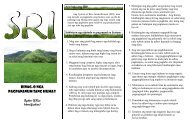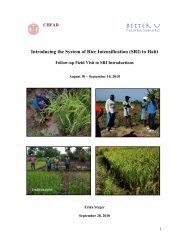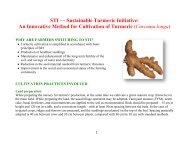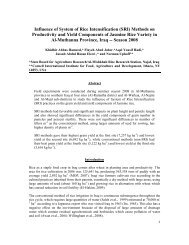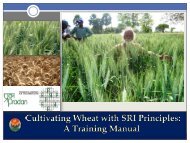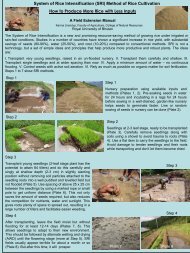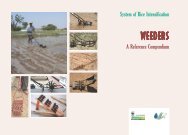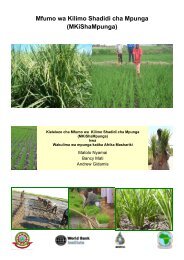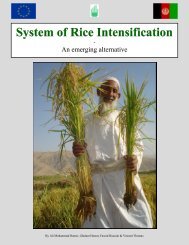EFFECT OF THE SYSTEM OF RICE INTENSIFICATION (SRI) ON ...
EFFECT OF THE SYSTEM OF RICE INTENSIFICATION (SRI) ON ...
EFFECT OF THE SYSTEM OF RICE INTENSIFICATION (SRI) ON ...
Create successful ePaper yourself
Turn your PDF publications into a flip-book with our unique Google optimized e-Paper software.
fertilizers which can increase N2O emissions (Nishimura et al., 2004; Mandal et al., 2008), drainage<br />
periods will not lead to heavy emissions of N2O.<br />
The other important <strong>SRI</strong> concept is the use of organic amendments (Laulanie, 1993) which will<br />
reduce all three GHGs (Yagi & Minami, 1990; Neue, 1993; Nayak et al., 2007) and increase the C<br />
content of the soil (Jarecki & Lal, 2003; Ramesh & Chandrasekaran, 2004; Mandal et al., 2008;<br />
Rajashekhara Rao & Siddaramappa, 2008). 93% of the farmers follow this <strong>SRI</strong> concept and their<br />
fields will therefore most likely have some influence on GHG emissions and build up of C pools.<br />
The fact that farmers remove the rice straw from the fields is removing nutrients, but removal of<br />
straw was according to Lou et al. (2007) found to decrease the emissions of CO2 and N2O. This is<br />
linked to the higher cellulose content of straw compared to the roots which will result in a slower<br />
decomposition of straw than roots (Lou et al., 2007).<br />
The degree of GHG emission reductions and C dynamics will very much depend on the applied<br />
amount of organic amendments and as discussed above in “compost production” are farmers able to<br />
collect quite a lot of natural fertilizers but they are not able to produce larger amounts of compost.<br />
Estimates are made on the C pool increase per year based on the organic inputs in table 9 and 10. If<br />
farmers in average would grow one ha or more with <strong>SRI</strong>, apply 3t/ha of compost/GM and have an<br />
average yield of 3.5 t rice per ha, a yearly input of C would be 348 kg C per ha per year which<br />
corresponds to close to 1% of the soil C pool of 49.5 t/ha. It is estimated that app. 1% of the C soil<br />
pool is mineralized per year thus resulting in a steady state where losses matches inputs app.<br />
Jarecki & Lal (2003) found similar results from a situation with a rice yield of 3.96 t ha -1 and input<br />
of crop residues amounting to 2.67 t ha -1 . They concluded that the soil C pool was enriched with<br />
401 kg C ha -1 annually (Jarecki & Lal, 2003). With the intensions of the ILFARM project to<br />
establish 500.000 trees the potential of storing larger amounts of C seems possible. Given the inputs<br />
assessed in section 9.5.5, under the nutrient budget, the plantings of e.g. Sesbania on 1 ha would<br />
yield 15 t ha -1 of green matter (Singh, 1984). Assuming a C percentage of 42 % (Brady & Weil,<br />
1999a) this would leave the farmers with an additional C input of 6300 kg/ha where however some<br />
parts would be lost due to decomposition especially if the Sesbania is added directly and not<br />
composted. Conservation tillage or no tillage could increase the C budget in the soil, it is however<br />
67



